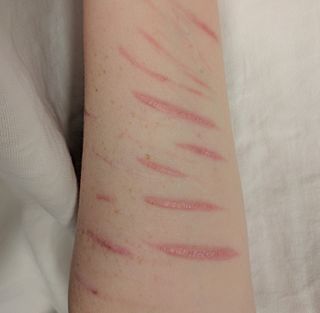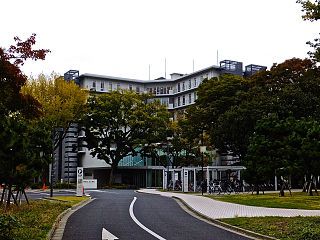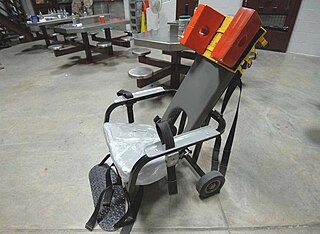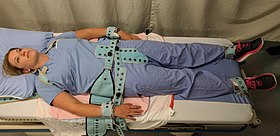
A psychiatric hospital, also known as a mental health hospital, or a behavioral health hospital, is a specialized medical facility that focuses on the treatment of severe mental disorders. These institutions cater to patients with conditions such as schizophrenia, bipolar disorder, major depressive disorder, and eating disorders, among others.

Self-harm is intentional conduct that is considered harmful to oneself. This is most commonly regarded as direct injury of one's own skin tissues, usually without suicidal intention. Other terms such as cutting, self-injury, and self-mutilation have been used for any self-harming behavior regardless of suicidal intent. Common forms of self-harm include damaging the skin with a sharp object or scratching with the fingernails, hitting, or burning. The exact bounds of self-harm are imprecise, but generally exclude tissue damage that occurs as an unintended side-effect of eating disorders or substance abuse, as well as more societally acceptable body modification such as tattoos and piercings.

Physical restraint refers to means of purposely limiting or obstructing the freedom of a person's or an animal's bodily movement.

Seclusion is the act of secluding, the state of being secluded, or a place that facilitates it. A person, couple, or larger group may go to a secluded place for privacy or peace and quiet. The seclusion of an individual is called solitude.

The health care system in Japan provides different types of services, including screening examinations, prenatal care and infectious disease control, with the patient accepting responsibility for 30% of these costs while the government pays the remaining 70%. Payment for personal medical services is offered by a universal health care insurance system that provides relative equality of access, with fees set by a government committee. All residents of Japan are required by the law to have health insurance coverage. People without insurance from employers can participate in a national health insurance program, administered by local governments. Patients are free to select physicians or facilities of their choice and cannot be denied coverage. Hospitals, by law, must be run as non-profits and be managed by physicians.
Suicide watch is an intensive monitoring process used to ensure that any person cannot attempt suicide. Usually the term is used in reference to inmates or patients in a prison, hospital, psychiatric hospital or military base. People are placed on suicide watch when it is believed that they exhibit warning signs indicating that they may be at risk of committing bodily harm or purposefully killing themselves.
Involuntary treatment refers to medical treatment undertaken without the consent of the person being treated. Involuntary treatment is permitted by law in some countries when overseen by the judiciary through court orders; other countries defer directly to the medical opinions of doctors.

Deinstitutionalisation is the process of replacing long-stay psychiatric hospitals with less isolated community mental health services for those diagnosed with a mental disorder or developmental disability. In the 1950's and 1960's, it led to the closure of many psychiatric hospitals, as patients were increasingly cared for at home, in halfway houses, group homes, and clinics, in regular hospitals, or not at all.

A padded cell or seclusion room is a controversial enclosure used in a psychiatric hospital or a special education setting in a private or public school, in which there are cushions lining the walls and sometimes has a cushioned floor as well. The padding is an attempt to prevent patients from hurting themselves by hitting their head on the hard surface of the walls. In most cases, an individual's placement in a padded cell is involuntary.

Psychiatry is the medical specialty devoted to the diagnosis, prevention, and treatment of deleterious mental conditions. These include various matters related to mood, behaviour, cognition, perceptions, and emotions.
Bridgewater State Hospital, located in southeastern Massachusetts, is a state facility housing the criminally insane and those whose sanity is being evaluated for the criminal justice system. It was established in 1855 as an almshouse. It was then used as a workhouse for inmates with short sentences who worked the surrounding farmland. It was later rebuilt in the 1880s and again in 1974. As of January 6, 2020 there were 217 inmates in general population beds. The facility was the subject of the 1967 documentary Titicut Follies. Bridgewater State Hospital falls under the jurisdiction of the Massachusetts Department of Correction but its day to day operations is managed by Wellpath, a contracted vendor.

Limb restraints can be physical restraints that inhibit an individual's movement in their arms or legs. The most common limb restraint is physical, whereby restraints are fixed to the individual in order to prevent movement of the limbs. They are most commonly used within the field of medicine. However, opposed to physical restraints, chemical restraints are forms of psychoactive medication that intentionally inhibit an individual's behaviour or movement.
Workplace safety in healthcare settings is similar to the workplace safety concerns in most occupations, but there are some unique risk factors, such as chemical exposures, and the distribution of injuries is somewhat different from the average of all occupations. Injuries to workers in healthcare settings usually involve overexertion or falling, such as strained muscles from lifting a patient or slipping on a wet floor. There is a higher than average risk of violence from other people, and a lower than average risk of transportation-related injuries.

The lunatic asylum, insane asylum or mental asylum was an institution where people with mental illness were confined. It was an early precursor of the modern psychiatric hospital.
Patient abuse or patient neglect is any action or failure to act which causes unreasonable suffering, misery or harm to the patient. Elder abuse is classified as patient abuse of those older than 60 and forms a large proportion of patient abuse.

A restraint chair is a type of physical restraint that is used to force an individual to remain seated in one place to prevent injury and harm to themselves or others. They are commonly used in prisons for violent inmates and hospitals for out of control patients. However, they have also been used to restrain prisoners at Guantanamo Bay detention camp during force-feeding.
The Keeping All Students Safe Act or KASSA is designed to protect children from the abuse of restraint and seclusion in school. The first Congressional bill was introduced in the United States House of Representatives on December 9, 2007, and named the Preventing Harmful Restraint and Seclusion in Schools Act. The primary sponsors of the two bills are Senator Tom Harkin (D-IA), Chair of the Senate Health, Education, Labor, and Pensions Committee, Congressman George Miller (D-CA), Ranking Member of the House Education and Workforce Committee, and Congressman Gregg Harper (R-MS).
Kelly Robert Savage was a New Zealand-American Assistant Language Teacher living in Japan whose death sparked an international outcry and a national debate in Japan about their psychiatric system and its use of long-term physical restraints. Savage was a dual citizen of New Zealand and the United States, and worked in Shibushi, Kagoshima in Japan from August 2015 until his death in May 2017.
Acute behavioral disturbance (ABD) is an umbrella term referring to various conditions of medical emergency where a person behaves in a manner that may put themselves or others at risk. It is not a formal diagnosis. Another controversial term, the widely rejected idea of excited delirium, is sometimes used interchangeably with ABD.

Olaseni Lewis, a 23-year-old British man, died on 3 September 2010 at Bethlem Royal Hospital in London, United Kingdom, after police subjected him to prolonged physical restraint. Lewis had voluntarily sought care following the onset of acute mental health issues and died from cerebral hypoxia soon after, following actions that involved eleven officers of London's Metropolitan Police. After seven years of campaigning by Lewis' family and two inquiries by the Independent Police Complaints Commission (IPCC), a second coroners' inquiry was raised.













